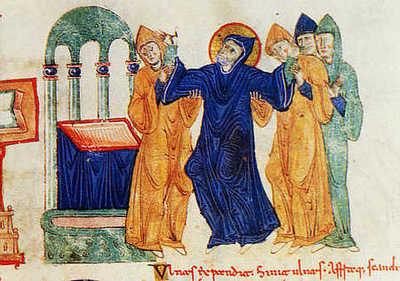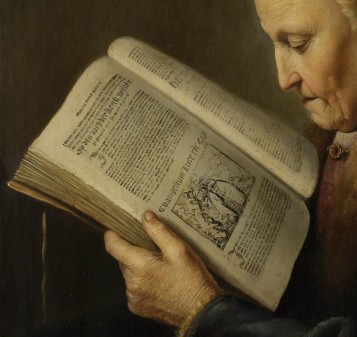Take me unto Thyself, O Lord

The Offering
Nowhere is the Eucharistic subtext of the Rule of Saint Benedict more apparent than in Chapters 58 and 59. The entire rite of monastic profession is presented as an oblation or, if you will, as a sacrificial immolation. The monk is a victim (hostia) offering himself to the Father through Christ, the Eternal High Priest.
Before the Altar
Saint Benedict sets the rite of monastic profession in the oratory of the monastery, that is, before the altar, the place of the Holy Sacrifice. There, with the Church on earth and in heaven as witness, he promises stability, conversion of his life, and obedience. He is surrounded by a great cloud of witnesses. The saints in heaven, represented on earth by the holy relics venerated in the monastery church, look on as the new monk lays his very life upon the altar. They intercede for the remission of his sins, that he may walk henceforth in newness of life, until at length he reaches the heavenly Jerusalem where they welcome him into the choirs of the blessed.
We pray Thee, Lord, by the merits of Thy saints whose relics are here, and of all the saints, that Thou wilt deign to pardon all my sins. Amen. (At Holy Mass, before the Introit)
Sacrifice
The act of profession is written out by the hand of the monk himself. In many monasteries this has become an act of love: the chart of profession is a thing of beauty, written in calligraphy, often with illuminations and considerable artistry. Saint Benedict emphasizes that the monk himself places the chart of profession, with his own hand, upon the altar. Writing in The City of God, Book Ten, Saint Augustine says that whatsoever is placed upon the altar becomes sacrificium, a true sacrifice, that is, a thing irrevocably made over to God alone. Like the bread and wine made over to God at the Offertory of the Mass, in view of the consecration, the newly-professed monk is an oblation made ready for consecration and immolation. The pattern of the ritual of profession and, effectively, the whole life of the monk is Eucharistic and sacrificial. It is a freely-chosen identification with Christ, Priest and Victim (Offerer and Offering), ratified by the Church.
Suscipe Me
“When he has placed it (the chart) there,” says Saint Benedict, “let the novice himself at once intone this verse: Suscipe me, Domine, secundum eloquium tuum, et vivam: et ne confundas me ab expectatione mea. “Take me unto Thyself, O Lord, and I shall live; and let me not be let down in my expectation.” Whenever Saint Benedict wants to emphasize a particular verse, he orders its threefold repetition. In this instance, not only does the newly-professed monk sing the verse three times; it is also repeated three times by the whole community, and crowned with the singing of the Gloria Patri. This confers upon the singing of the Suscipe a character of solemnity and grandeur. It signifies the moment in which the Father lays claim to the self-offering of the new monk, in whom He recognizes the pattern of His own Beloved Son’s immolation from the altar of the Cross.
Facing God
This understanding of the victimal and sacrificial character of monastic profession has alas, waned in recent years, because the presentation and understanding of the Mass itself as Our Lord’s Holy Sacrifice to the Father, renewed in an unbloody manner, has suffered an eclipse in the minds of the faithful. This can be attributed, I think, in no small measure, to the widespread (and almost universal) loss of priest and people facing together in a single Godward direction at the moment of offering the Holy Sacrifice. The restoration of the position versus Deum for the Offertory and Canon of the Mass will be the single most effective tool in presenting a renewed catechesis of the Holy Sacrifice of the Mass and of a sacrificing priesthood.
The Sacrifice Offered in Thy Sight
The Suscipe of the newly-professed monk finds an echo in the Offertory prayers of the Mass:
Suscipe, Sancte Pater . . . Take unto Thyself, Holy Father, almighty and everlasting God this unblemished sacrificial offering, which I Thy unworthy servant, make to Thee, my living and true God, for my countless sins, offences, and neglects, and on behalf of all who are present here; likewise for all believing Christians, living and dead. Accept it for their good and mine, so that it may save us, and bring us to everlasting life. Amen.
Again, the prayer after the offering of chalice, might well be said by the monk offering himself:
In spiritu humilitatis . . . Humbled in spirit and contrite of heart, may we find favour with Thee, O Lord, and may our sacrifice be so offered in Thy sight this day that it may please Thee, Lord God.
The word Suscipe occurs again in the prayer that concludes the Offertory rite:
Take unto Thyself, O Holy Trinity, the offering we here make to Thee in memory of the passion, resurrection, and ascension of Our Lord Jesus Christ; in honour, too, of blessed Mary, ever-virgin, of blessed John the Baptist, of the holy apostles Peter and Paul, of these, and of all the saints. To them let it bring honour, to us salvation, and may they whom we are commemorating on earth deign to plead for us in heaven: through the same Christ our Lord. Amen.
Orate, Fratres
Finally, Saint Benedict, directs the newly-professed and offered monk to prostrate himself before the feet of each monk in the community, asking them to pray for him. While, in many monastic communities this rite has suffered a deformation, becoming a gesture of welcome and of congratulations, such is not the mind of our holy legislator. Saint Benedict has the new monk kneel at the feet of his fathers in Christ to beg their prayers. The rite has a certain analogy with the Orate, Fratres of the Mass:
Pray brethren, that my sacrifice and yours may find acceptance with God the almighty Father. R. May the Lord accept the sacrifice at your hands, to the praise and glory of His Name, for our welfare also, and that of all His holy Church.
Following this, in the traditional rite of monastic profession and consecration, the monk prostrates himself before the altar for the entire duration of the Holy Mysteries. “There lies there,” says Dom Delatte, “a living man, a man renewed; there is a living victim, “a pure, holy, and unspotted victim,” reunited to the victim on the altar, offered and accepted with that same victim, and enwrapped by the deacon in the fragrance of the same incense.” The great teaching abbot of Solesmes goes on to say:
Then the Mass continues. Motionless and silent like the Lamb of God, the newly professed suffers himself to be immolated and consumed mystically by the Eternal High Priest. How sweet that Mass and that Communion. Our whole monastic life should resemble this profession Mass.

